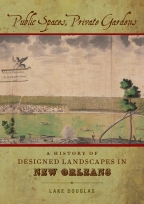
320 pages / 7.00 x 10.00 inches / 77 halftones, 20 color plates
Gardening | Louisiana Studies | Science / Environmental History
Landscape architect Lake Douglas employs written accounts, archival data, historic photographs, lithographs, maps, and city planning documents--many of which have never before been published--to explore public and private outdoor spaces in New Orleans and those who shaped them. The result offers the first in-depth examination of the city's landscape history.
Douglas presents this "beautiful and imposing" city as a work of art crafted by numerous influences. His survey from the colonial period to the twentieth century finds that geography, climate, and, above all, the multicultural character of its residents have made New Orleans unique in American landscape design history. French and Spanish settlers, Africans and Native Americans, as well as immigrants from Germany, Ireland, Italy, and other parts of the world all participated in creating this community's unique public and private landscapes.
Places such as Congo Square, Audubon Park, the river levees, and "neutral grounds"--local residents' own term for medians--together with ordinary residential gardens are all testaments to the city's international imprint. Douglas identifies five types of public and private designed landscapes in New Orleans: squares, linear open spaces, urban parks, commercial pleasure gardens, and domestic gardens.
Discussing their design, function, and content, he shows how specific examples of each contribute to the city's unique character and also fit within the larger context of American landscape design history. Each type has its own complexion and reflects the influence of those who occupied it. Though New Orleanians lived in strata according to language, cultural identity, economics, and race, they found common ground, literally, in their community's landscapes.
Douglas's sweeping study, illustrated with over 90 color and black-and-white images, includes an exploration of archival horticultural books, almanacs, and periodicals; information about laborers who actually built landscapes; details of horticultural commerce, services, and marketing materials; and an exhaustive inventory of plants grown in New Orleans for agricultural, medicinal, and ornamental uses.
Public Spaces, Private Gardens provides an informative look at two hundred years of the designed landscapes and horticulture of New Orleans and a fresh perspective on one of America's most interesting and historic cities.
Lake Douglas is Associate Dean of Research & Development at Louisiana State University’s College of Art and Design and associate professor in the Robert Reich School of Landscape Architecture. He is the author of Public Spaces, Private Gardens: A History of Designed Landscapes in New Orleans.
“More than just a description of the historical creation of gardens, this book provides the reader with an important background of the amazing history of the city with regard to immigration, racial and cultural practices, and the agricultural economy, all trends that shaped the creation and use of space and landscape in the city.”—Material Culture
Found an Error? Tell us about it.